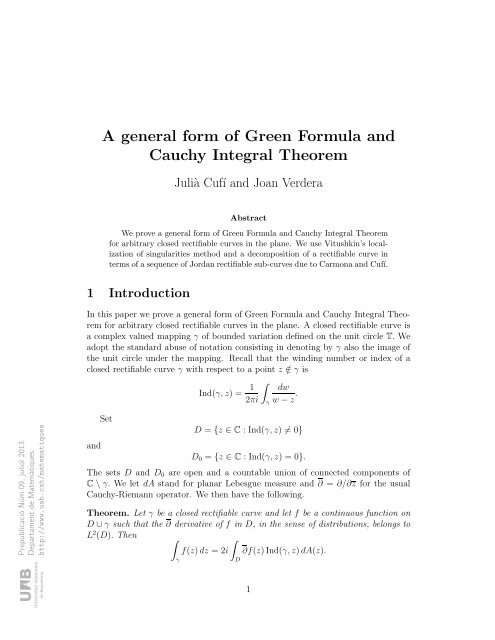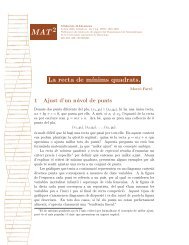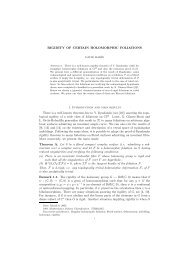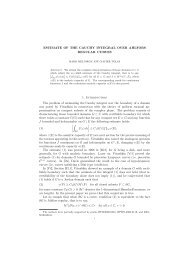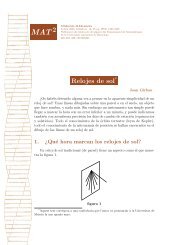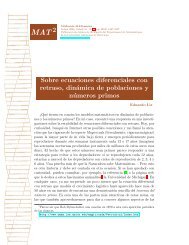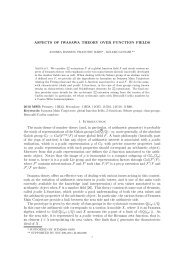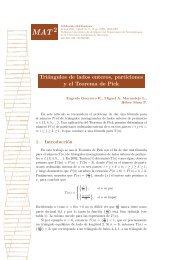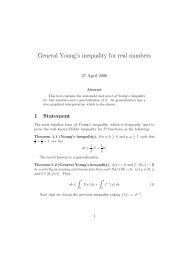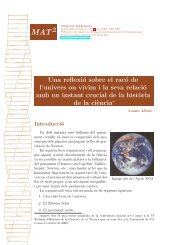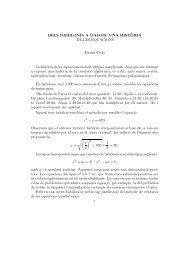A general form of Green Formula and Cauchy Integral Theorem
A general form of Green Formula and Cauchy Integral Theorem
A general form of Green Formula and Cauchy Integral Theorem
- No tags were found...
You also want an ePaper? Increase the reach of your titles
YUMPU automatically turns print PDFs into web optimized ePapers that Google loves.
A <strong>general</strong> <strong>form</strong> <strong>of</strong> <strong>Green</strong> <strong>Formula</strong> <strong>and</strong><strong>Cauchy</strong> <strong>Integral</strong> <strong>Theorem</strong>Julià Cufí <strong>and</strong> Joan VerderaAbstractWe prove a <strong>general</strong> <strong>form</strong> <strong>of</strong> <strong>Green</strong> <strong>Formula</strong> <strong>and</strong> <strong>Cauchy</strong> <strong>Integral</strong> <strong>Theorem</strong>for arbitrary closed rectifiable curves in the plane. We use Vitushkin’s localization<strong>of</strong> singularities method <strong>and</strong> a decomposition <strong>of</strong> a rectifiable curve interms <strong>of</strong> a sequence <strong>of</strong> Jordan rectifiable sub-curves due to Carmona <strong>and</strong> Cufí.1 IntroductionIn this paper we prove a <strong>general</strong> <strong>form</strong> <strong>of</strong> <strong>Green</strong> <strong>Formula</strong> <strong>and</strong> <strong>Cauchy</strong> <strong>Integral</strong> <strong>Theorem</strong>for arbitrary closed rectifiable curves in the plane. A closed rectifiable curve isa complex valued mapping γ <strong>of</strong> bounded variation defined on the unit circle T. Weadopt the st<strong>and</strong>ard abuse <strong>of</strong> notation consisting in denoting by γ also the image <strong>of</strong>the unit circle under the mapping. Recall that the winding number or index <strong>of</strong> aclosed rectifiable curve γ with respect to a point z /∈ γ isInd(γ, z) = 12πi∫γdww − z .Prepublicació Núm 09, juliol 2013.Departament de Matemàtiques.http://www.uab.cat/matematiques<strong>and</strong>SetD = {z ∈ C : Ind(γ, z) ≠ 0}D 0 = {z ∈ C : Ind(γ, z) = 0}.The sets D <strong>and</strong> D 0 are open <strong>and</strong> a countable union <strong>of</strong> connected components <strong>of</strong>C \ γ. We let dA st<strong>and</strong> for planar Lebesgue measure <strong>and</strong> ∂ = ∂/∂z for the usual<strong>Cauchy</strong>-Riemann operator. We then have the following.<strong>Theorem</strong>. Let γ be a closed rectifiable curve <strong>and</strong> let f be a continuous function onD ∪ γ such that the ∂ derivative <strong>of</strong> f in D, in the sense <strong>of</strong> distributions, belongs toL 2 (D). Then ∫∫f(z) dz = 2i ∂f(z) Ind(γ, z) dA(z).γD1
If D is empty then the right h<strong>and</strong> side in (1) is 0 <strong>and</strong> the identity is straightforward.Notice that the integral in the right h<strong>and</strong> side is absolutely convergentbecause the function Ind(γ, z) is in L 2 (C). This was proven with the best constantin [CC1]. It is also a consequence <strong>of</strong> the Sobolev imbedding <strong>Theorem</strong> for p = 1 <strong>and</strong>the fact that Ind(γ, z) is a function <strong>of</strong> bounded variation. Indeed∂(Ind(γ, z)) = dz2i<strong>and</strong>∂(Ind(γ, z)) = − dz2i .It is not true in <strong>general</strong> that Ind(γ, z) ∈ L p (C) for some p > 2. Our pro<strong>of</strong> works alsounder the assumption that ∂f(z) Ind(γ, z) ∈ L 1 (D).Corollary. Let γ be a closed rectifiable curve <strong>and</strong> let f be a holomorphic functionon D which is continuous on D ∪ γ. Then∫f(z) dz = 0.γWith the extra hypothesis that Ind(γ, z) is bounded on C \ γ the Corollary wasproven by Nöbeling in 1949 [N]. In fact, the corollary is proven in [M] as a consequence<strong>of</strong> an approximation theorem <strong>of</strong> γ by chains <strong>form</strong>ed by boundaries <strong>of</strong> squarescontained in D. Michael’s approximation theorem coupled with a regularization argumentcan be used to give a pro<strong>of</strong> <strong>of</strong> the <strong>Theorem</strong> above. Our pro<strong>of</strong>, which wefound before becoming aware <strong>of</strong> [M], keeps the curve fixed <strong>and</strong>, instead, the functionf is suitably approximated.Combining the <strong>Theorem</strong> with a well known result <strong>of</strong> Fesq [F] (see also [Co]) oneobtains an appealing statement in which no distributions theory is involved. Fesqproved the following. Assume that a function f is defined <strong>and</strong> continuous on an openset Ω <strong>and</strong> has partial derivatives ∂f/∂x <strong>and</strong> ∂f/∂y at each point <strong>of</strong> Ω \ E, whereE is a countable union <strong>of</strong> closed sets <strong>of</strong> finite length (one dimensional Hausdorffmeasure). Assume further that the measurable function ∂f(z) = 1( ∂f ∂f(z) + i (z))2 ∂x ∂ydefined for z ∈ Ω \ E, belongs to L 1 loc (Ω). We emphasize that now ∂f(z) is notdefined in the sense <strong>of</strong> distributions but only pointwise. Then∫∫f(z) dz = 2i ∂f(z) dA(z), (1)∂Qfor each square Q with closure contained in Ω. It is not difficult to realize that(1) implies that the pointwise ∂-derivative <strong>of</strong> f on Ω is indeed the distributional∂-derivative <strong>of</strong> f on Ω. For the sake <strong>of</strong> completeness a pro<strong>of</strong> <strong>of</strong> this simple fact ispresented in section 4. Therefore we obtain the following variation <strong>of</strong> the <strong>Theorem</strong>.<strong>Theorem</strong> (pointwise version). Let γ be a closed rectifiable curve. Let f be acontinuous function on D ∪ γ whose partial derivatives ∂f/∂x <strong>and</strong> ∂f/∂y exist ateach point <strong>of</strong> D \ E, where E is a countable union <strong>of</strong> closed sets <strong>of</strong> finite length (oneQ2
dimensional Hausdorff measure), <strong>and</strong> such that ∂f ∈ L 2 (D), where ∂f is definedpointwise almost everywhere on D. Then∫∫f(z) dz = 2i ∂f(z) Ind(γ, z) dA(z).γDIn [M] a weaker version <strong>of</strong> the preceding result is proven under the extra assumptionthat ∂f(z)/∂x Ind(γ, z) <strong>and</strong> ∂f(z)/∂y Ind(γ, z) are in L 1 (D).In section 2 we present the pro<strong>of</strong> <strong>of</strong> the <strong>Theorem</strong> <strong>and</strong> we leave for section 3the discussion <strong>of</strong> the Main Lemma. The main tool in the pro<strong>of</strong> is the method <strong>of</strong>separation <strong>of</strong> singularities due to Vitushkin (see [G], [V] or [Vi]). This is quite naturalbecause in many instances <strong>Cauchy</strong> <strong>Integral</strong> <strong>Theorem</strong> is reduced to the case in whichmore regular functions are involved via uni<strong>form</strong> approximation <strong>of</strong> the given data.For instance, if D is a Jordan domain <strong>and</strong> γ its boundary, then one can approximatef, uni<strong>form</strong>ly on D, by polynomials in z, for which the result is obvious.Vitushkin’s method produces a large finite sum. The terms in this sum aredivided into three classes <strong>and</strong> in estimating the class which involves more directlythe curve we decompose γ in a sum, in most cases infinite, <strong>of</strong> Jordan curves. Thisdecomposition is a consequence <strong>of</strong> [CC2, <strong>Theorem</strong> 4] <strong>and</strong> reads as follows.<strong>Theorem</strong> (Carmona <strong>and</strong> Cufí). For each closed rectifiable curve γ such thatD ≠ ∅ there exists a sequence (maybe finite) <strong>of</strong> Jordan curves (γ n ) ∞ n=1 with theproperty that γ n ⊂ γ, dz γ = ∑ ∞n=1 dz γ n<strong>and</strong> ∑ ∞n=1 l(γ n) ≤ l(γ).Here l(γ) st<strong>and</strong>s for the length <strong>of</strong> the curve γ <strong>and</strong> dz γ = ∑ ∞n=1 dz γ nmeans that∫γ f(z) dz = ∑ ∞∫n=1 γ nf(z) dz, for any continuous function f on γ.The estimate we are looking for is then reduced to the case <strong>of</strong> a Jordan curve,which is dealt with in the Main Lemma.A word on the existing literature on <strong>Green</strong> <strong>Formula</strong> <strong>and</strong> <strong>Cauchy</strong> <strong>Integral</strong> <strong>Theorem</strong>is in order. Burckel, in his well-known comprehensive book on Classical ComplexAnalysis [B, p. 341], states that the more <strong>general</strong> <strong>Cauchy</strong> <strong>Theorem</strong> he knows is thatdue to Nöbeling ([N]), in which the index <strong>of</strong> the curve is assumed to be bounded. Heseems to be unaware <strong>of</strong> Michael’s article [M], which is apparently widely unknown.We believe that the <strong>general</strong> <strong>form</strong> <strong>of</strong> <strong>Green</strong> <strong>Formula</strong> <strong>and</strong> <strong>Cauchy</strong> <strong>Integral</strong> <strong>Theorem</strong>involving arbitrary rectifiable curves <strong>and</strong> functions defined in the minimal domainD ∪ γ deserves to be better known.2 Pro<strong>of</strong> <strong>of</strong> the <strong>Theorem</strong>We first describe Vitushkin’s scheme to separate singularities <strong>of</strong> functions. The firststep is the construction <strong>of</strong> partitions <strong>of</strong> unity subordinated to special coverings <strong>of</strong>the plane by discs <strong>of</strong> equal radii.Lemma 1. Given any δ > 0 there exists a countable family <strong>of</strong> discs (∆ j ) <strong>of</strong> radiusδ <strong>and</strong> a family <strong>of</strong> functions ϕ j ∈ C ∞ 0 (∆ j ) such that3
(i) C = ∪ j ∆ j .(ii) The family (∆ j ) is almost disjoint, that is, for some constant C each z ∈ Cbelongs to at most C discs ∆ j (in fact we can take C = 21).(iii) ∑ j ϕ j = 1, 0 ≤ ϕ j <strong>and</strong> |∇ϕ j (z)| ≤ Cδ −1 , z ∈ C, where C is an absoluteconstant.For the pro<strong>of</strong>, take a grid <strong>of</strong> squares <strong>of</strong> side length δ/2 <strong>and</strong> regularize the characteristicfunction <strong>of</strong> each square with an appropriate approximation <strong>of</strong> the identity(see [V, p.440-441], [G] or [Vi].Given a compactly supported continuous function f on the plane, setf j = 1πz ∗ ϕ j ∂f, (2)which makes sense, because it is the convolution <strong>of</strong> the compactly supported distributionϕ j ∂f with the locally integrable function 1 . Since 1 is the fundamentalπz πzsolution <strong>of</strong> the differential operator ∂, we have ∂f j = ϕ j ∂f <strong>and</strong> thus f j is holomorphicwhere f is <strong>and</strong> <strong>of</strong>f a compact subset <strong>of</strong> ∆ j . It is easy to see thatf j (z) = 1 ∫ f(w) − f(z)∂ϕ j (w) dA(w)π w − z<strong>and</strong> hence|f j (z)| ≤ C ω(f, δ), z ∈ C,where C is an absolute constant <strong>and</strong> ω(f, δ) is the modulus <strong>of</strong> continuity <strong>of</strong> f. Sincethe family <strong>of</strong> functions (ϕ j ) is a partition <strong>of</strong> the unity,f = ∑ jf j . (3)If one defines a singularity <strong>of</strong> f as a point in the support <strong>of</strong> ∂f, then clearly theeffect <strong>of</strong> (3) is to distribute the singularities <strong>of</strong> f among the discs ∆ j . Notice thatthe sum in (3) contains only finitely many non-zero terms, because the support <strong>of</strong>∂f is compact.Having set up these preliminaries, let us start the pro<strong>of</strong> <strong>of</strong> the <strong>Theorem</strong>. We willconsider only the case in which D is not empty; otherwise the conclusion is straightforward.Extend the function f to a compactly supported continuous function onthe plane, fix a δ > 0 <strong>and</strong> apply (3). We divide the indexes j into the followingthree classes :<strong>and</strong>I = {j : ∆ j ⊂ D},II = {j : ∆ j ∩ γ ≠ ∅},III = {j : ∆ j ⊂ D 0 }.4
For j ∈ III we have ∫ f γ j(z) dz = 0, because f j is holomorphic on an open setin which γ is homologous to zero. Hence∑∫f j (z) dz = 0.Sincej∈IIIFor j ∈ I use the definition <strong>of</strong> f j in (2) <strong>and</strong> Fubini’s theorem to get∫∫f j (z) dz = 2i ϕ j (w) ∂f(w) Ind(γ, w) dA(w).γAdding up in j ∈ I one obtains∑∫j∈Iγ∫ ( ) ∑f j (z) dz = 2i ϕ j (w)Cj∈Ilimδ→0Cγ∑ϕ j (w) = 1,j∈I∂f(w) Ind(γ, w) dA(w).w ∈ D<strong>and</strong> ∂f(w) Ind(γ, w) ∈ L 1 (D), it follows, by dominated convergence, that∑∫∫f j (z) dz = 2i ∂f(w) Ind(γ, w) dA(w).Therefore∫γlimδ→0j∈Iγ∫f(z) dz = 2iCC∑∂f(z) Ind(γ, z) dA(z) + limδ→0j∈II∫γf j (z) dz<strong>and</strong> so to complete the pro<strong>of</strong> it is enough to check that the limit in the above righth<strong>and</strong> side vanishes. This follows from the inequality∑∫∣ f j (z) dz∣ ≤ C ω(f, δ) l(γ) + η(δ), (4)j∈IIγwhere C is an absolute constant <strong>and</strong> η(δ) a function which tends to zero with δ. Toshow (4) fix j ∈ II. One has∫∣ ∣ ∣∣∣∣ ∣∣∣∣ ∫∣ f j (z) dz∣ = f j (z) dzγ∫γ∩∆ j∣ + f j (z) dzγ∩(∆ j ) ∣c ∫(5)≤ C ω(f, δ) l(γ ∩ ∆ j ) +f j (z) dz∣ γ∩(∆ j ) ∣ . c5
Observe that adding up on j ∈ II the first terms in right h<strong>and</strong> side <strong>of</strong> the inequalityabove one gets the desired estimate, namely,∑ω(f, δ) l(γ ∩ ∆ j ) ≤ C ω(f, δ) l(γ),j∈IIwhere we used that the family <strong>of</strong> discs ∆ j is almost disjoint. However, the obviousestimate for the second term∫f j (z) dz∣ γ∩(∆ j ) ∣ ≤ C ω(f, δ) l(γ ∩ (∆ j) c )cdoes not lead anywhere because the length <strong>of</strong> γ <strong>of</strong>f the disc ∆ j is not under control.To overcome this difficulty we resort to the next lemma.Main Lemma. Let Γ be a closed rectifiable Jordan curve, ∆ a disc <strong>of</strong> radius δ <strong>and</strong>h a bounded continuous function on C, holomorphic <strong>of</strong>f a compact subset <strong>of</strong> ∆. Then∫∣ h(z) dz∣ ≤ 2π ‖h‖ ∞ δ, (6)Γ∩(∆) cwhere ‖h‖ ∞ is the supremum norm <strong>of</strong> h on the whole plane.We postpone the pro<strong>of</strong> <strong>of</strong> the Main Lemma to next section <strong>and</strong> we proceed t<strong>of</strong>inish the pro<strong>of</strong> <strong>of</strong> the <strong>Theorem</strong>.First <strong>of</strong> all we prove (4) with η ≡ 0 assuming that γ = Γ is a Jordan curve.Consider the case δ ≤ 1 diam(Γ). Since there is a point in Γ ∩ ∂∆ 2 j the length <strong>of</strong>the curve in the disc 3∆ j is larger than 2δ. Combining (5) with the Main Lemmaapplied to f j <strong>and</strong> ∆ j we conclude that∫∣ f j (z) dz∣ ≤ C ω(f, δ) l(Γ ∩ (3∆ j),Γwhich yields (4) with η ≡ 0, because the family <strong>of</strong> discs (3∆ j ) is almost disjoint.If δ > 1 diam(Γ), then the number <strong>of</strong> discs ∆ 2 j that intersect Γ is less than anabsolute constant. Thus (4) with η ≡ 0 <strong>and</strong> γ replaced by Γ also holds in this case.Now we will reduce the pro<strong>of</strong> <strong>of</strong> (4) to the case <strong>of</strong> a Jordan curve by appealingto the decomposition theorem <strong>of</strong> [CC2] mentioned in the introduction. There isa sequence (maybe finite) <strong>of</strong> rectifiable Jordan curves (γ n ) ∞ n=1 such that γ n ⊂ γ,dz γ = ∑ ∞n=1 dz γ n<strong>and</strong> ∑ ∞n=1 l(γ n) ≤ l(γ). We need to decompose II into two subsets.Let II 0 be the set <strong>of</strong> indices j ∈ II such that D j does not intersect any γ n <strong>and</strong>II 1 = II \ II 0 . Since the set <strong>of</strong> indices II is finite, we have∣ ∑ ∣∣∣ f j (z) dz∣j∈II∫γ≤ ∑ ∞ ∑∫∣ f j (z) dz∣1 j∈II 1 n=1 γ n∣ ∞∑ ∑∫∣∣∣ =f j (z) dz∣ .n=1 j∈IIγ n 16
Given n = 1, 2, ... set II n = {j : ∆ j ∩ γ n ≠ ∅}. Each j ∈ II 1 belongs to at leastone II n , but may belong to several. Taking into account this remark in the firstinequality below <strong>and</strong> applying (4) with η ≡ 0 to the Jordan curve γ n <strong>and</strong> the functionf in the second one, we get∣ ∞∑ ∑∫∣∣∣ ∞ ∣f j (z) dz∣ ≤ ∑ ∑∫∣∣∣ f j (z) dz∣n=1 j∈IIγ n 1 n=1 j∈IIγ n n∞∑≤ C ω(f, δ) l(γ n )n=1≤ C ω(f, δ) l(γ),which is the right estimate.∑We turn now our attention to the sum over II 0 . If j ∈ II 0 then Ind(γ, z) =∞n=1 Ind(γ n, z) is constant on ∆ j \ γ. Hence ∆ j \ γ ⊂ D 0 or ∆ j \ γ ⊂ D.In the first case we argue as we did for j ∈ III. The infinite cycle ∑ ∞n=1 γ n is homologousto 0 in an open set on which f j is holomorphic <strong>and</strong> therefore ∫ f γ j(z) dz =∑ ∞∫n=1 γ nf j (z) dz = 0. This follows by the usual argument to prove <strong>Cauchy</strong>’s <strong>Theorem</strong>for finite cycles.To settle the case ∆ j \ γ ⊂ D we need to know that the ∂-derivative <strong>of</strong> f on ∆ jdoes not charge the set γ ∩ ∆ j .Lemma 2. Let ∆ be an open disc <strong>and</strong> assume that ∆\γ ⊂ D. Then the ∂-derivative<strong>of</strong> f on ∆ in the distributions sense is the function ∂f(z) χ ∆\γ (z).Pro<strong>of</strong>. It is shown in Appendix 1(section 4) that the conclusion <strong>of</strong> the Lemma followsfrom the identity∫∫f(z) dz = 2i ∂f(z) χ ∆\γ (z) dA(z), (7)∂QQfor each closed square Q with sides parallel to the coordinates axis contained in ∆.To prove (7) subdivide Q in dyadic sub-squares. At the n-th generation one has 4 ndyadic sub-squares <strong>of</strong> Q, denoted by Q k , 1 ≤ k ≤ 4 n . Their side length is L 4 −n , Lbeing the side length <strong>of</strong> Q. Set I = {k : Q k ∩ γ = ∅} <strong>and</strong> J = {k : Q k ∩ γ ≠ ∅}.Then∫f(z) dz = ∑ ∫f(z) dz + ∑ ∫f(z) dz∂Qk∈I∂Q k k∈J∂Q k= ∑ ∫2i ∂f(z) dA(z) + ∑ ∫(f(z) − f(z k )) dzk∈IQ k k∈J∂Q k≡ T 1 (n) + T 2 (n),7
where z k is any point in Q k <strong>and</strong> the last identity is a definition <strong>of</strong> T 1 (n) <strong>and</strong> T 2 (n).On the one h<strong>and</strong> it is clear that∫lim T 1(n) = 2i ∂f(z) χ ∆\γ (z) dA(z)n→∞<strong>and</strong> on the other h<strong>and</strong>, setting ǫ n = √ 2L4 −n , we haveQ|T 2 (n)| ≤ ω(f, ǫ n ) ∑ k∈Jl(∂Q k ).Take n big enough so that diam(2Q k ) = √ 2 2L4 −n < diam(γ). Then l(∂Q k ) ≤8 l(2Q k ∩ γ) <strong>and</strong> thus|T 2 (n)| ≤ C ω(f, ǫ n )l(γ),because the family <strong>of</strong> squares 2Q k , 1 ≤ k ≤ 4 n , is almost disjoint (with an absoluteconstant). Letting n → ∞ we get (7).Denote by II 2 the set <strong>of</strong> indices j ∈ II 0 such that ∆ j \ γ ⊂ D. For j ∈ II 2 , byFubini’s theorem <strong>and</strong> Lemma 2,∫∫f j (z) dz = 2i ϕ j (w) ∂f(w) χ ∆j \γ(w) Ind(γ, w) dA(w)γ∫= 2iCDϕ j (w) ∂f(w) Ind(γ, w) dA(w),which is the same relation we found for indices j ∈ I. It is also clear that for someBorel subset E <strong>of</strong> γ, lim δ→0∑j∈II 2ϕ j (z) = χ E (z), z ∈ C. Therefore∑∣ ∫∣∣∣ f j (z) dz∣j∈II∫γ≤ 2 0D( ∑j∈II 2ϕ j (z))|∂f(z) Ind(γ, z)| dA(z) ≡ η(δ)<strong>and</strong>, since E ⊂ γ, η(δ) tends to zero with δ. This completes the pro<strong>of</strong> <strong>of</strong> (4) <strong>and</strong> <strong>of</strong>the <strong>Theorem</strong>.3 Pro<strong>of</strong> <strong>of</strong> the Main LemmaWe can assume , without loss <strong>of</strong> <strong>general</strong>ity, that Γ intersects the circle ∂∆ in finitelymany points. Indeed, by the Banach Indicatrix <strong>Theorem</strong> [Na, p. 225] applied to thefunction <strong>of</strong> bounded variation |γ|, there is a sequence <strong>of</strong> numbers λ n > 1 with limit1 such that Γ intersects ∂(λ n ∆) in finitely many points. It is readily shown that theinequality (6) follows as soon as one knows it for the discs λ n ∆. Assume then thatΓ intersects the circle ∂∆ in finitely many points.8
We claim that there are finitely many subintervals (I k ) <strong>of</strong> the circle ∂∆, whichare mutually disjoint, such that∫h(z) dz = ∑ ǫ k h(z) dz, (8)Γ∩(∆) c k∫I kwhere ǫ k = ±1 determines the orientation on the interval I k (ǫ k = 1 corresponds tothe counterclockwise orientation <strong>of</strong> ∂∆). It is plain that (8) completes the pro<strong>of</strong> <strong>of</strong>the Main Lemma.Take a connected component C <strong>of</strong> Γ ∩ (∆) c . The open Jordan arc C has two endpoints on ∂∆ ,which determine two complementary open intervals I 1 <strong>and</strong> I 2 in ∂∆.Each I j , j = 1, 2, determines a closed Jordan curve C j which is the union <strong>of</strong> C <strong>and</strong>the closure <strong>of</strong> I j . We claim that one <strong>and</strong> only one <strong>of</strong> the two closed curves C j hasindex zero with respect to the center z <strong>of</strong> ∆. This means that the domain enclosedby this Jordan curve lies completely outside the closed disc ∆. To show the claimtake a path joining z with ∞ without touching the closure <strong>of</strong> C. Consider the pointw where this path leaves the disc ∆ for the last time. Modifying the path by takingfirst the segment joining z with w, we may assume that it indeed intersects ∂∆ atonly one point w, which belongs to I 1 or I 2 . If it lies on I 2 then the index <strong>of</strong> C 1with respect to z is 0 <strong>and</strong> the index <strong>of</strong> C 2 with respect z is ±1. The case w ∈ I 1 issymmetric <strong>and</strong> so the claim is proven.Given a connected component C <strong>of</strong> Γ∩(∆) c , we define I(C) to be the interval I j inthe preceding discussion such that the domain enclosed by C j lies in the complement<strong>of</strong> ∆.I 0 kFigure 19
If C 1 <strong>and</strong> C 2 are two different components <strong>of</strong> Γ ∩ (∆) c then I(C 1 ) ⊂ I(C 2 ) orI(C 2 ) ⊂ I(C 1 ) or the intervals I(C 1 ) <strong>and</strong> I(C 2 ) have disjoint interiors. This “dyadic”structure allows a classification <strong>of</strong> the intervals I(C) in generations. Since there arefinitely many components <strong>of</strong> Γ ∩ (∆) c some <strong>of</strong> the intervals I(C) are maximal withrespect to inclusion. These are said to be <strong>of</strong> generation 0 <strong>and</strong> they <strong>form</strong> a set G 0 .If an interval I(C) is contained in exactly one interval <strong>of</strong> G 0 it is said to be <strong>of</strong>generation 1. The intervals I(C) <strong>of</strong> generation 1 <strong>form</strong> a set G 1 . In this way we defineinductively intervals I(C) <strong>of</strong> generation p <strong>and</strong> the corresponding set G p <strong>of</strong> intervals<strong>of</strong> generation p. Clearly there are only finitely many generations (see Figure 1).To construct the intervals (I k ) in (8) we proceed inductively as follows. Noticethat the subset <strong>of</strong> ∂∆∪ I∈G0 (I \ ∪ I⊃J∈G1 J)is a union <strong>of</strong> disjoint intervals. Call this intervals (Ik 0 ). We then have, for appropriatelychosen ǫ k = ±1,∑h(z) dz +∑∫ǫ k h(z) dz. (9)I(C)∈G 0∫CI(C)∈G 1∫Ch(z) dz = ∑ kThis is a consequence <strong>of</strong> <strong>Cauchy</strong>’s integral theorem applied to the function h <strong>and</strong>the Jordan curves defined as follows. For each I(C 0 ) ∈ G 0 define the Jordan curvewhich consists <strong>of</strong> the arc C 0 , the arcs C such that I(C) ∈ G 1 <strong>and</strong> I(C) ⊂ I(C 0 )<strong>and</strong> the intervals Ik 0 ⊂ I(C 0). The subarcs <strong>of</strong> Γ keep the orientation <strong>of</strong> Γ <strong>and</strong> theorientation on the Ik 0 can be chosen so that (9) holds because <strong>of</strong> a topological factthat we discuss below.We say that Γ enters the disc ∆ at the point Γ(t 0 ) ∈ ∂∆ if there is ǫ > 0 with theproperty that Γ(t) ∈ (∆) c for t 0 −ǫ < t < t 0 <strong>and</strong> Γ(t) ∈ ∆ for t 0 < t < t 0 +ǫ. We saythat Γ leaves the disc ∆ at the point Γ(t 0 ) ∈ ∂∆ if there is ǫ > 0 with the propertythat Γ(t) ∈ ∆ for t 0 − ǫ < t < t 0 <strong>and</strong> Γ(t) ∈ (∆) c for t 0 < t < t 0 + ǫ. There is a thirdcategory <strong>of</strong> points in Γ ∩ ∂∆, namely those with the property that the curve justbefore <strong>and</strong> just after the point stays either in the disc or in the complement <strong>of</strong> itsclosure. We will ignore these points. Consider now two points in Γ ∩ ∂∆ at whichΓ enters or leaves the disc <strong>and</strong> assume that in one <strong>of</strong> the complementary intervalsin ∂∆ determined by these two points there is no other point at which Γ enters orleaves the disc. Then we claim that at one <strong>of</strong> the two points the curve enters thedisc <strong>and</strong> at the other the curve leaves the disc. In other words, it is not possible thateither the curve enters the disc at both points or that the curve leaves the disc atboth points. Before embarking in the pro<strong>of</strong> <strong>of</strong> this claim we remark that, with (9)at our disposition, <strong>and</strong> arguing inductively with the intervals <strong>of</strong> generation 2 <strong>and</strong>subsequent (if any), we finally get (8).To prove the claim, take two points A <strong>and</strong> B in Γ ∩ ∂∆ at which Γ enters orleaves the disc <strong>and</strong> assume that in one <strong>of</strong> the complementary open intervals in ∂∆determined by A <strong>and</strong> B there is no other point at which Γ enters or leaves the disc.Then we have to show that the curve enters the disc at one <strong>of</strong> the points A <strong>and</strong> B<strong>and</strong> leaves the disc at the other.10I 0 k
p in the clockwise direction until we are under the middle point <strong>of</strong> the interval ÂB.Continue along the ray emanating at the center <strong>of</strong> ∆ towards ∂∆, cross ∂∆ <strong>and</strong>proceed until you touch the circle concentric with ∂∆ containing q. Then followthat circle until you get to q. Obviously you cross Γ AB once through ÂB, but thereis no other intersection with Γ AB . The pro<strong>of</strong> is now complete.4 AppendixIn this section we prove the following.Lemma 3. Assume that f is a continuous function on an open set Ω such that itspartial derivatives exist almost everywhere in Ω <strong>and</strong> ∂f ∈ L 1 loc (Ω). Assume furtherthat∫∫f(z) dz = 2i ∂f(z) dA(z), (10)∂Qfor each closed square Q ⊂ Ω with sides parallel to the coordinates axis. Then thepointwise ∂ derivative <strong>of</strong> f on Ω is indeed the distributional derivative <strong>of</strong> f on Ω.QPro<strong>of</strong>. One has to show that∫∫− f(z) ∂ϕ(z) dA(z) =∂f(z) ϕ(z) dA(z), (11)∫for each ϕ ∈ C0 ∞ (Ω). Take ρ ∈ C0 ∞ (C) with support contained in {z : |z| ≤ 1} <strong>and</strong>ρ(z) dA(z) = 1. Set ρǫ (z) = 1 ρ( z ) <strong>and</strong> f ǫ 2 ǫ ǫ = f ∗ ρ ǫ . Then ∂(f ∗ ρ ǫ ) = f ∗ ∂ρ ǫ ,but it is not clear that this coincides with ∂f ∗ ρ ǫ . Given δ > 0 set Ω δ = {z ∈ Ω :dist(z, ∂Ω) > δ} <strong>and</strong> take δ small enough so that the support <strong>of</strong> ϕ is contained inΩ δ . Let ǫ < δ. Then∫∫− f ǫ (z) ∂ϕ(z) dA(z) = − (f ∗ ρ ǫ )(z) ∂ϕ(z) dA(z),We show now that∫=∂(f ∗ ρ ǫ )(z) ϕ(z) dA(z)∫= (f ∗ ∂ρ ǫ )(z) ϕ(z) dA(z).(12)(f ∗ ∂ρ ǫ )(z) = (∂f ∗ ρ ǫ )(z), z ∈ Ω δ . (13)Inserting this in (12) <strong>and</strong> letting ǫ → 0 yields (11). To prove (13) let Q be the closedsquare with sides parallel to the coordinate axis with center z <strong>and</strong> side length 2ǫ.Then Q ⊂ Ω. The function g(w) = f(w)ρ ǫ (z − w) vanishes on the boundary <strong>of</strong> Q.Applying (10) to Q <strong>and</strong> g we get (13).12
Acknowledgements. The authors are grateful to J.Bruna <strong>and</strong> M.Melnikov forsome useful conversations on the subject.This work was partially supported by the grants 2009SGR420 (Generalitat deCatalunya) <strong>and</strong> MTM2010-15657 (Ministerio de Educación y Ciencia).References[B]R.B. Burckel, An Introduction to Classical Complex Analysis, Vol. 1 AcademicPress, New York <strong>and</strong> San Francisco, 1979.[CC1] J.J. Carmona <strong>and</strong> J. Cufí, The index <strong>of</strong> a plane curve <strong>and</strong> <strong>Green</strong>’s <strong>form</strong>ula,Rend. Circolo Matem. Palermo 53(2004), 103–128.[CC2] J.J. Carmona <strong>and</strong> J. Cufí, The calculation <strong>of</strong> the L 2 -norm <strong>of</strong> the index<strong>of</strong> a plane curve <strong>and</strong> related <strong>form</strong>ulae, to appear in Journal d’AnalyseMathématique.[Co] P.J. Cohen, On <strong>Green</strong>’s theorem, Proc. Amer. Math. Soc. 10(1959), 109–112.[F][G][M][Na][N][V][Vi]R.M. Fesq, <strong>Green</strong>’s <strong>form</strong>ula, linear continuity, <strong>and</strong> Hausdorff measure, Trans.Amer. Math. Soc. 118(6) (1965), 105–112.T.W. Gamelin, Uni<strong>form</strong> Algebras, Prentice Hall, Englewood Cliffs, New Jersey,1969.J.H. Michael, An approximation to a rectifiable plane curve, J. London Math.Soc. 30 (1955), 1–11.I.P. Natanson, Theory <strong>of</strong> Functions <strong>of</strong> a real variable, Vol. 1, Frederich UngarPubl., New York, 1961.G. Nöbeling Eine allgemeine Fassung des Hauptsatzes der Funktionentheorievon <strong>Cauchy</strong>, (German) Math. Ann. 121 (1949), 54–66.J. Verdera, Removability, capacity <strong>and</strong> approximation, in: NATO Adv. Sci.Int. Ser. C Math. Phys. Sci., 439, Kluwer, Dordrecht (1994), 419–473.A. G. Vitushkin, The analytic capacity <strong>of</strong> sets in problems <strong>of</strong> approximationtheory, Uspekhi Mat. Nauk. 22 (1967), 141–199 (Russian); English transl.,Russian Math. Surveys 22 (1967), 139–200.Julià Cufí <strong>and</strong> Joan VerderaDepartament de MatemàtiquesUniversitat Autònoma de Barcelona08193 Bellaterra, Barcelona, CataloniaE-mail: jcufi@mat.uab.catE-mail: jvm@mat.uab.cat13


